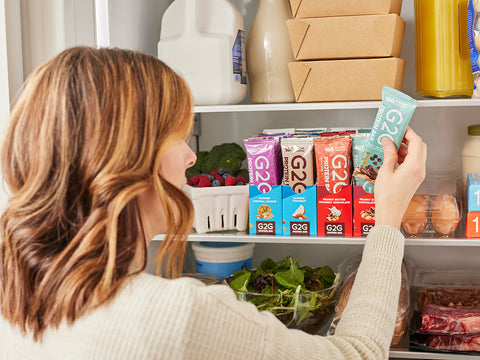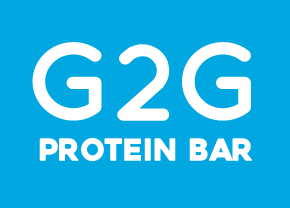The Truth About Sugar from a Registered Dietitian
By: Marisa Landetta, RDN
I'm Marisa Landetta, a Registered Dietitian with Celiac Disease and a specialty in weight management. Living with Celiac Disease means that I have to eat a completely gluten free diet, and it can be tough to find safe foods that are also nutritious. I'm a big fan of G2G bars, because they are completely gluten free and Celiac safe, made in a dedicated facility to prevent the risk of cross contamination. I also absolutely love that G2G bars are whole foods based and provide 18g of protein per bar, so they're great to rely on for a protein boost.
One of the most common questions I see about G2G bars is about the sugar content, so I wanted to write this article to debunk the myth that all sugar is bad, and to answer some of the common questions about the sugar content in G2G bars.
What Is Added Sugar?
On a nutrition facts label you'll see "total sugar" and "added sugar" listed, here's the difference:
- Total Sugar: natural sugar, including from fruit and milk, and added sugar
- Added Sugar: sugar added to food during processing
The FDA Recommends not exceeding 50 grams of added sugar per day based on a 2,000 calorie diet, but I often encourage people to try to get closer to 30 grams per day if possible.
For reference, G2G bars contain about 13g of total sugar and only 11g of added sugar per bar, so eating about 3 bars a day would fit within the recommended limits of added sugar per day.
Not All Sweeteners Are Created Equal
It's important to understand the difference between natural sweeteners and artificial sweeteners when reading a label. Let's take a look at the difference.
Natural Sweeteners include:
- Honey
- Brown Sugar
- Coconut Sugar
- Brown Rice Syrup
- Maple Syrup
- Date Syrup and Paste
- Agave
Natural sweeteners are real-food based sweeteners, but they are still considered added sugars, because they are being added to food to make it sweeter. Due to the fact that natural sweeteners are real-food based, they also contain other vitamins and nutrients that support our bodies' health.
This is one of the reasons why it's important to understand the differences between natural and artificial sweeteners on the ingredient list, because just looking at the added sugar amount doesn't tell you the whole story. When choosing an added sugar option, it is best to choose one that comes from a natural source, like the options listed above.
G2G takes pride in being a whole foods based product, which means they exclusively use natural sweeteners including honey, organic brown rice syrup, and coconut sugar crystals, and they contain no artificial sweeteners or sugar alcohols in their bars.
Artificial Sweeteners and Sugar Alcohols
Some common Artificial Sweeteners include:
- Sucralose
- Aspartame
- Saccharin
Some common Sugar Alcohols include:
- Erythritol
- Xylitol
- Sorbitol
This may come at a surprise to you, but these sweeteners are not considered added sugars and do not contribute to the added sugar amount on nutrition labels nor do they contribute to the recommended daily sugar amount. This is because these sweeteners are mimicking the taste of sugar, and they are just that - artificial.
The recommended intake of these artificial sweeteners varies and is dependent on body size, but it's overall recommended to limit intake of artificial sweeteners since they can have some negative effects on health.
Why Sugar Is Important
Our bodies rely on sugar, or glucose, to run properly. We need a certain amount each day to perform our best and have enough energy. You don't have to cut out all sugar to live a healthy, well-balanced life and doing so can lead to a lot of confusion, guilt, and just an unhealthy relationship with food. Understanding the differences between natural and artificial sweeteners is important to understand so you can have awareness of where your sugar intake is coming from and feel empowered to make the best decision for your body.
As a Registered Dietitian, I can confidently recommend G2G bars to my clients, because they are naturally sweetened, whole food based, and Celiac safe. I can rely on them to provide a great protein boost, they're satisfying, and most importantly, they taste incredible!
References
1. U.S. Food and Drug Administration. (2022, March 17). Added sugars on the Nutrition Facts label.
https://www.fda.gov/food/nutrition-facts-label/added-sugars-nutrition-facts-label
2. U.S. Food and Drug Administration. (2022, July 28). Aspartame and other sweeteners in food.
https://www.fda.gov/food/food-additives-petitions/aspartame-and-other-sweeteners-food
18 Grams of Protein
Finding it hard to get enough protein in your diet? Each G2G Bar has 18 grams of muscle building, fat burning, metabolism boosting protein!Certified Gluten-Free
Every G2G Bar is certified gluten-free, making it the perfect snack for anyone sensitive or allergic to gluten. Enjoy worry-free nutrition with each bite.Good for 30-days on the go
Keep your energy up with G2G Bars, fresh for 30 days outside the fridge. Ideal for busy lives, they offer a convenient, nutritious boost anytime.More Articles


Why Refrigerated?
"Why do your bars need to be refrigerated when most other protein bars don't?"

